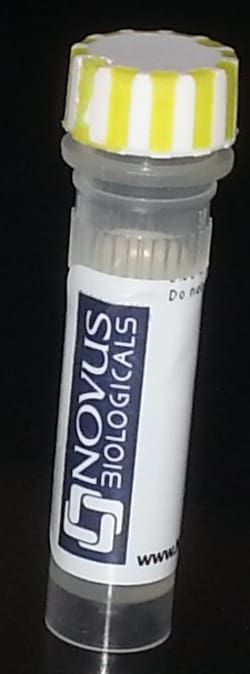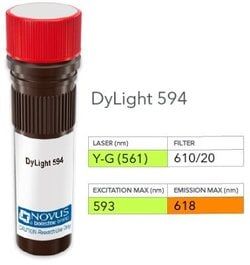GFAP Antibody (GA-5), Alexa Fluor™ 750, Novus Biologicals™
Manufacturer: Novus Biologicals
Select a Size
| Pack Size | SKU | Availability | Price |
|---|---|---|---|
| Each of 1 | NP233184A70-Each-of-1 | In Stock | ₹ 61,810.50 |
NP233184A70 - Each of 1
In Stock
Quantity
1
Base Price: ₹ 61,810.50
GST (18%): ₹ 11,125.89
Total Price: ₹ 72,936.39
Antigen
GFAP
Classification
Monoclonal
Conjugate
Alexa Fluor 750
Formulation
50 mM sodium borate with 0.05% sodium azide
Gene Symbols
GFAP
Immunogen
GFAP isolated from pig spinal cord (Uniprot: P14136)
Purification Method
Protein G purified
Research Discipline
Astrocyte Markers, Cancer, Cell Biology, Cellular Markers, Chaperone Mediated Autophagy (CMA), Inflammation, Neurodegeneration, Neuroscience, Signal Transduction, Stem Cell Markers
Gene ID (Entrez)
2670.0
Target Species
Human, Mouse, Rat, Porcine, Bovine, Chicken, Rabbit
Isotype
IgG1 κ
Applications
Western Blot, ELISA, Immunohistochemistry, Immunohistochemistry (Paraffin)
Clone
GA-5
Dilution
Western Blot, ELISA, Immunohistochemistry, Immunohistochemistry-Paraffin
Gene Alias
FLJ45472, GFAP astrocytes, glial fibrillary acidic protein
Host Species
Mouse
Molecular Weight of Antigen
50 kDa
Quantity
0.1 mL
Primary or Secondary
Primary
Test Specificity
This monoclonal antibody recognizes a protein of ∼50kDa which is identified as Glial Fibrillary Acidic Protein (GFAP). It shows no cross-reaction with other intermediate filament proteins. GFAP is specifically found in astroglia. GFAP is a very popular marker for localizing benign astrocyte and neoplastic cells of glial origin in the central nervous system. Antibody to GFAP is useful in differentiating primary gliomas from metastatic lesions in the brain and for documenting astrocytic differentiation in tumors outside the CNS.
Content And Storage
Store at 4°C in the dark.
Description
- GFAP Monoclonal specifically detects GFAP in Human, Mouse, Rat, Porcine, Bovine, Chicken, Rabbit samples
- It is validated for Western Blot, Flow Cytometry, Immunohistochemistry, Immunocytochemistry/Immunofluorescence, Immunohistochemistry-Paraffin, Immunohistochemistry-Frozen.

